Commercial and Corporation Law Report: IP, Copyright and Pre-emption
VerifiedAdded on 2023/05/31
|6
|1462
|299
Report
AI Summary
This report delves into the complexities of federal pre-emption within the realm of commercial and corporation law, particularly focusing on intellectual property rights, copyright, and related state law claims. It examines two recent judgments from the Fourth and Fifth Circuits, which provide clarity on federal pre-emption concerning state law claims related to adaptation, computer fraud, and unfair competition. The report analyzes the application of Section 301 of the Copyright Act, the right of publicity, and the implications of federal pre-emption on IP protection. It further discusses the measures companies can take to protect their intellectual property, including legal strategies, market surveillance, and employee training. The report references key court cases, such as Open Risk, LLC v. Micro Strategy Services Corporation and Laws v. Sony Music Entm’t, Inc., to illustrate the legal principles and practical considerations involved in IP protection and pre-emption.
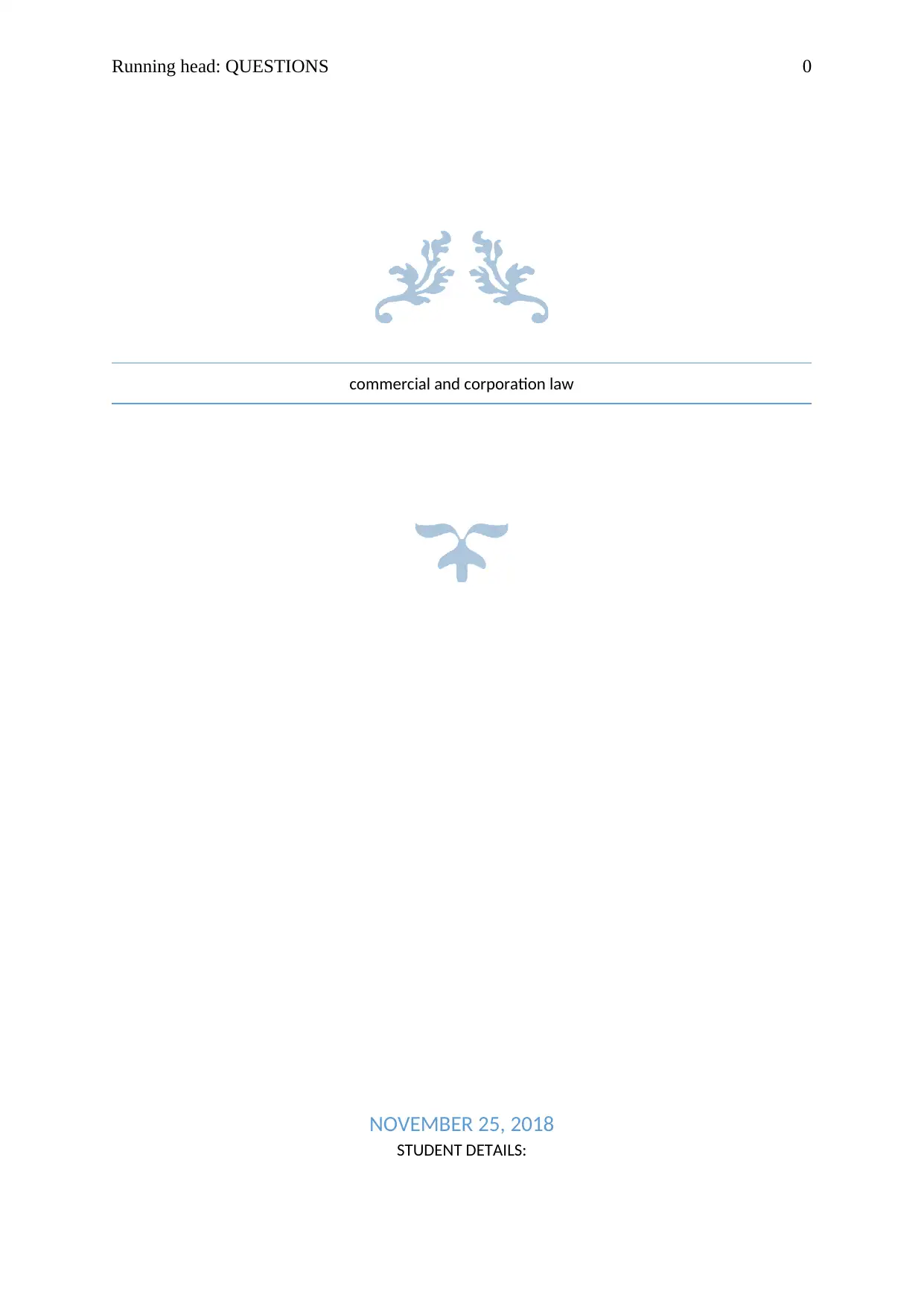
Running head: QUESTIONS 0
commercial and corporation law
NOVEMBER 25, 2018
STUDENT DETAILS:
commercial and corporation law
NOVEMBER 25, 2018
STUDENT DETAILS:
Paraphrase This Document
Need a fresh take? Get an instant paraphrase of this document with our AI Paraphraser
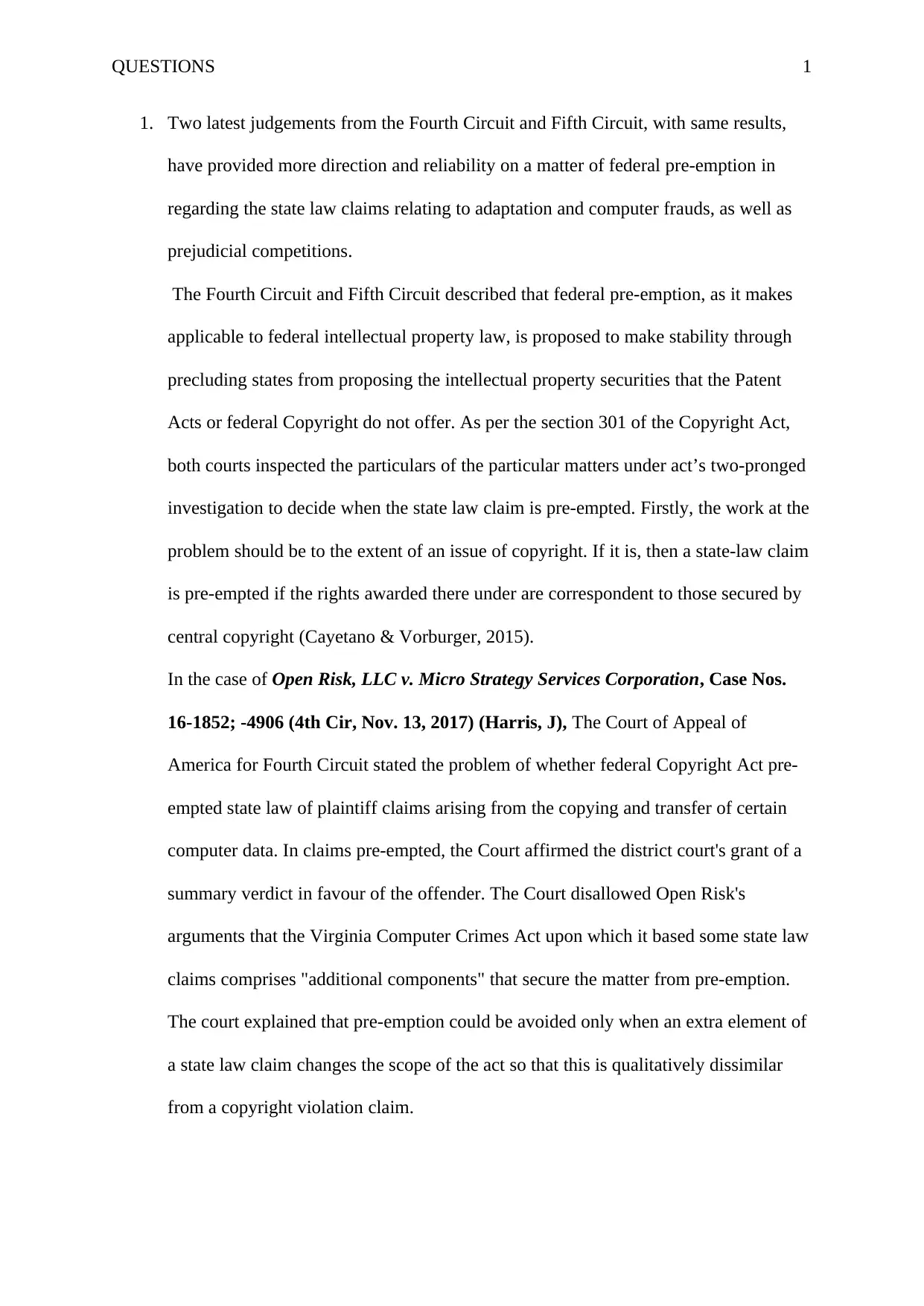
QUESTIONS 1
1. Two latest judgements from the Fourth Circuit and Fifth Circuit, with same results,
have provided more direction and reliability on a matter of federal pre-emption in
regarding the state law claims relating to adaptation and computer frauds, as well as
prejudicial competitions.
The Fourth Circuit and Fifth Circuit described that federal pre-emption, as it makes
applicable to federal intellectual property law, is proposed to make stability through
precluding states from proposing the intellectual property securities that the Patent
Acts or federal Copyright do not offer. As per the section 301 of the Copyright Act,
both courts inspected the particulars of the particular matters under act’s two-pronged
investigation to decide when the state law claim is pre-empted. Firstly, the work at the
problem should be to the extent of an issue of copyright. If it is, then a state-law claim
is pre-empted if the rights awarded there under are correspondent to those secured by
central copyright (Cayetano & Vorburger, 2015).
In the case of Open Risk, LLC v. Micro Strategy Services Corporation, Case Nos.
16-1852; -4906 (4th Cir, Nov. 13, 2017) (Harris, J), The Court of Appeal of
America for Fourth Circuit stated the problem of whether federal Copyright Act pre-
empted state law of plaintiff claims arising from the copying and transfer of certain
computer data. In claims pre-empted, the Court affirmed the district court's grant of a
summary verdict in favour of the offender. The Court disallowed Open Risk's
arguments that the Virginia Computer Crimes Act upon which it based some state law
claims comprises "additional components" that secure the matter from pre-emption.
The court explained that pre-emption could be avoided only when an extra element of
a state law claim changes the scope of the act so that this is qualitatively dissimilar
from a copyright violation claim.
1. Two latest judgements from the Fourth Circuit and Fifth Circuit, with same results,
have provided more direction and reliability on a matter of federal pre-emption in
regarding the state law claims relating to adaptation and computer frauds, as well as
prejudicial competitions.
The Fourth Circuit and Fifth Circuit described that federal pre-emption, as it makes
applicable to federal intellectual property law, is proposed to make stability through
precluding states from proposing the intellectual property securities that the Patent
Acts or federal Copyright do not offer. As per the section 301 of the Copyright Act,
both courts inspected the particulars of the particular matters under act’s two-pronged
investigation to decide when the state law claim is pre-empted. Firstly, the work at the
problem should be to the extent of an issue of copyright. If it is, then a state-law claim
is pre-empted if the rights awarded there under are correspondent to those secured by
central copyright (Cayetano & Vorburger, 2015).
In the case of Open Risk, LLC v. Micro Strategy Services Corporation, Case Nos.
16-1852; -4906 (4th Cir, Nov. 13, 2017) (Harris, J), The Court of Appeal of
America for Fourth Circuit stated the problem of whether federal Copyright Act pre-
empted state law of plaintiff claims arising from the copying and transfer of certain
computer data. In claims pre-empted, the Court affirmed the district court's grant of a
summary verdict in favour of the offender. The Court disallowed Open Risk's
arguments that the Virginia Computer Crimes Act upon which it based some state law
claims comprises "additional components" that secure the matter from pre-emption.
The court explained that pre-emption could be avoided only when an extra element of
a state law claim changes the scope of the act so that this is qualitatively dissimilar
from a copyright violation claim.
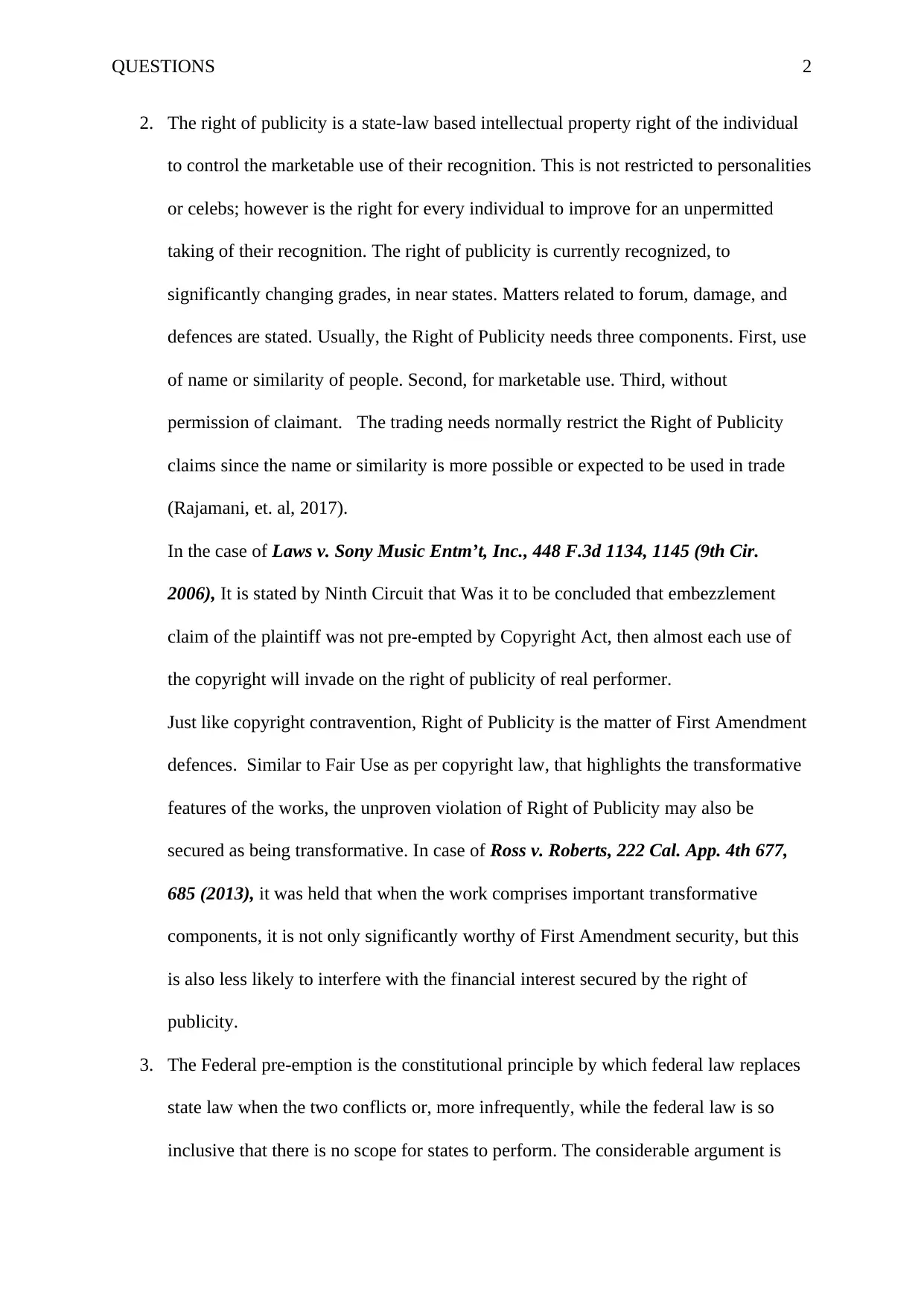
QUESTIONS 2
2. The right of publicity is a state-law based intellectual property right of the individual
to control the marketable use of their recognition. This is not restricted to personalities
or celebs; however is the right for every individual to improve for an unpermitted
taking of their recognition. The right of publicity is currently recognized, to
significantly changing grades, in near states. Matters related to forum, damage, and
defences are stated. Usually, the Right of Publicity needs three components. First, use
of name or similarity of people. Second, for marketable use. Third, without
permission of claimant. The trading needs normally restrict the Right of Publicity
claims since the name or similarity is more possible or expected to be used in trade
(Rajamani, et. al, 2017).
In the case of Laws v. Sony Music Entm’t, Inc., 448 F.3d 1134, 1145 (9th Cir.
2006), It is stated by Ninth Circuit that Was it to be concluded that embezzlement
claim of the plaintiff was not pre-empted by Copyright Act, then almost each use of
the copyright will invade on the right of publicity of real performer.
Just like copyright contravention, Right of Publicity is the matter of First Amendment
defences. Similar to Fair Use as per copyright law, that highlights the transformative
features of the works, the unproven violation of Right of Publicity may also be
secured as being transformative. In case of Ross v. Roberts, 222 Cal. App. 4th 677,
685 (2013), it was held that when the work comprises important transformative
components, it is not only significantly worthy of First Amendment security, but this
is also less likely to interfere with the financial interest secured by the right of
publicity.
3. The Federal pre-emption is the constitutional principle by which federal law replaces
state law when the two conflicts or, more infrequently, while the federal law is so
inclusive that there is no scope for states to perform. The considerable argument is
2. The right of publicity is a state-law based intellectual property right of the individual
to control the marketable use of their recognition. This is not restricted to personalities
or celebs; however is the right for every individual to improve for an unpermitted
taking of their recognition. The right of publicity is currently recognized, to
significantly changing grades, in near states. Matters related to forum, damage, and
defences are stated. Usually, the Right of Publicity needs three components. First, use
of name or similarity of people. Second, for marketable use. Third, without
permission of claimant. The trading needs normally restrict the Right of Publicity
claims since the name or similarity is more possible or expected to be used in trade
(Rajamani, et. al, 2017).
In the case of Laws v. Sony Music Entm’t, Inc., 448 F.3d 1134, 1145 (9th Cir.
2006), It is stated by Ninth Circuit that Was it to be concluded that embezzlement
claim of the plaintiff was not pre-empted by Copyright Act, then almost each use of
the copyright will invade on the right of publicity of real performer.
Just like copyright contravention, Right of Publicity is the matter of First Amendment
defences. Similar to Fair Use as per copyright law, that highlights the transformative
features of the works, the unproven violation of Right of Publicity may also be
secured as being transformative. In case of Ross v. Roberts, 222 Cal. App. 4th 677,
685 (2013), it was held that when the work comprises important transformative
components, it is not only significantly worthy of First Amendment security, but this
is also less likely to interfere with the financial interest secured by the right of
publicity.
3. The Federal pre-emption is the constitutional principle by which federal law replaces
state law when the two conflicts or, more infrequently, while the federal law is so
inclusive that there is no scope for states to perform. The considerable argument is
⊘ This is a preview!⊘
Do you want full access?
Subscribe today to unlock all pages.

Trusted by 1+ million students worldwide
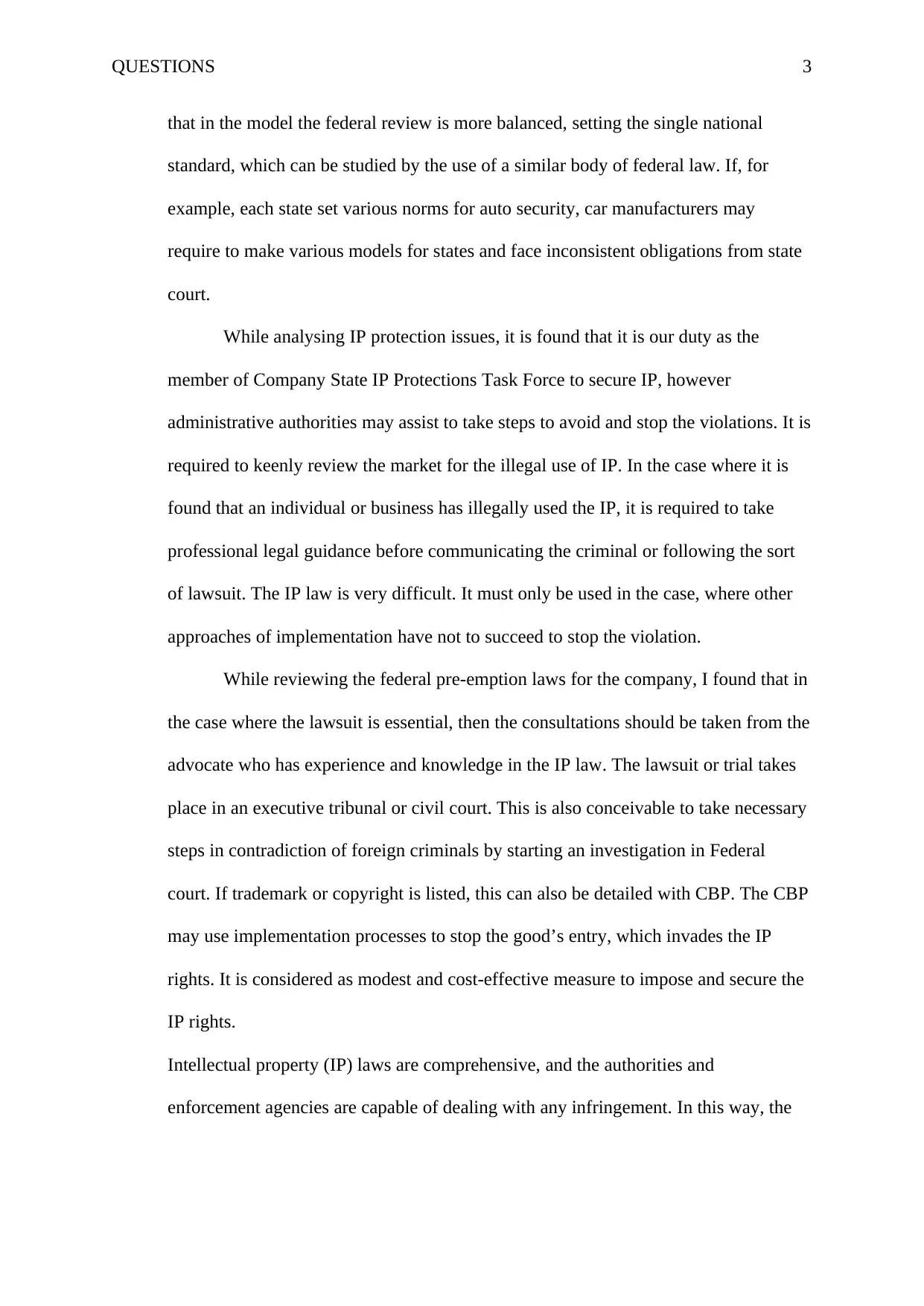
QUESTIONS 3
that in the model the federal review is more balanced, setting the single national
standard, which can be studied by the use of a similar body of federal law. If, for
example, each state set various norms for auto security, car manufacturers may
require to make various models for states and face inconsistent obligations from state
court.
While analysing IP protection issues, it is found that it is our duty as the
member of Company State IP Protections Task Force to secure IP, however
administrative authorities may assist to take steps to avoid and stop the violations. It is
required to keenly review the market for the illegal use of IP. In the case where it is
found that an individual or business has illegally used the IP, it is required to take
professional legal guidance before communicating the criminal or following the sort
of lawsuit. The IP law is very difficult. It must only be used in the case, where other
approaches of implementation have not to succeed to stop the violation.
While reviewing the federal pre-emption laws for the company, I found that in
the case where the lawsuit is essential, then the consultations should be taken from the
advocate who has experience and knowledge in the IP law. The lawsuit or trial takes
place in an executive tribunal or civil court. This is also conceivable to take necessary
steps in contradiction of foreign criminals by starting an investigation in Federal
court. If trademark or copyright is listed, this can also be detailed with CBP. The CBP
may use implementation processes to stop the good’s entry, which invades the IP
rights. It is considered as modest and cost-effective measure to impose and secure the
IP rights.
Intellectual property (IP) laws are comprehensive, and the authorities and
enforcement agencies are capable of dealing with any infringement. In this way, the
that in the model the federal review is more balanced, setting the single national
standard, which can be studied by the use of a similar body of federal law. If, for
example, each state set various norms for auto security, car manufacturers may
require to make various models for states and face inconsistent obligations from state
court.
While analysing IP protection issues, it is found that it is our duty as the
member of Company State IP Protections Task Force to secure IP, however
administrative authorities may assist to take steps to avoid and stop the violations. It is
required to keenly review the market for the illegal use of IP. In the case where it is
found that an individual or business has illegally used the IP, it is required to take
professional legal guidance before communicating the criminal or following the sort
of lawsuit. The IP law is very difficult. It must only be used in the case, where other
approaches of implementation have not to succeed to stop the violation.
While reviewing the federal pre-emption laws for the company, I found that in
the case where the lawsuit is essential, then the consultations should be taken from the
advocate who has experience and knowledge in the IP law. The lawsuit or trial takes
place in an executive tribunal or civil court. This is also conceivable to take necessary
steps in contradiction of foreign criminals by starting an investigation in Federal
court. If trademark or copyright is listed, this can also be detailed with CBP. The CBP
may use implementation processes to stop the good’s entry, which invades the IP
rights. It is considered as modest and cost-effective measure to impose and secure the
IP rights.
Intellectual property (IP) laws are comprehensive, and the authorities and
enforcement agencies are capable of dealing with any infringement. In this way, the
Paraphrase This Document
Need a fresh take? Get an instant paraphrase of this document with our AI Paraphraser
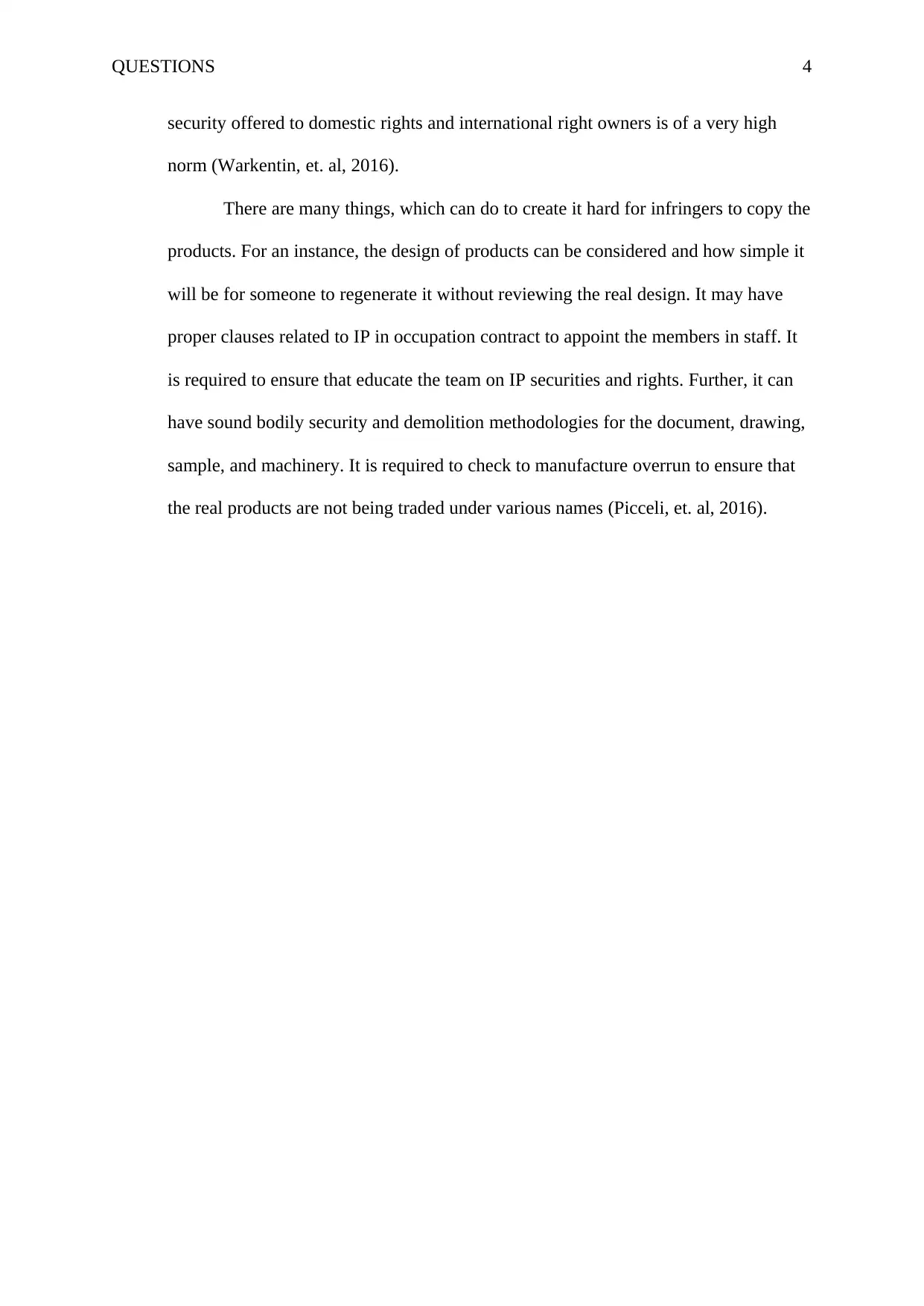
QUESTIONS 4
security offered to domestic rights and international right owners is of a very high
norm (Warkentin, et. al, 2016).
There are many things, which can do to create it hard for infringers to copy the
products. For an instance, the design of products can be considered and how simple it
will be for someone to regenerate it without reviewing the real design. It may have
proper clauses related to IP in occupation contract to appoint the members in staff. It
is required to ensure that educate the team on IP securities and rights. Further, it can
have sound bodily security and demolition methodologies for the document, drawing,
sample, and machinery. It is required to check to manufacture overrun to ensure that
the real products are not being traded under various names (Picceli, et. al, 2016).
security offered to domestic rights and international right owners is of a very high
norm (Warkentin, et. al, 2016).
There are many things, which can do to create it hard for infringers to copy the
products. For an instance, the design of products can be considered and how simple it
will be for someone to regenerate it without reviewing the real design. It may have
proper clauses related to IP in occupation contract to appoint the members in staff. It
is required to ensure that educate the team on IP securities and rights. Further, it can
have sound bodily security and demolition methodologies for the document, drawing,
sample, and machinery. It is required to check to manufacture overrun to ensure that
the real products are not being traded under various names (Picceli, et. al, 2016).
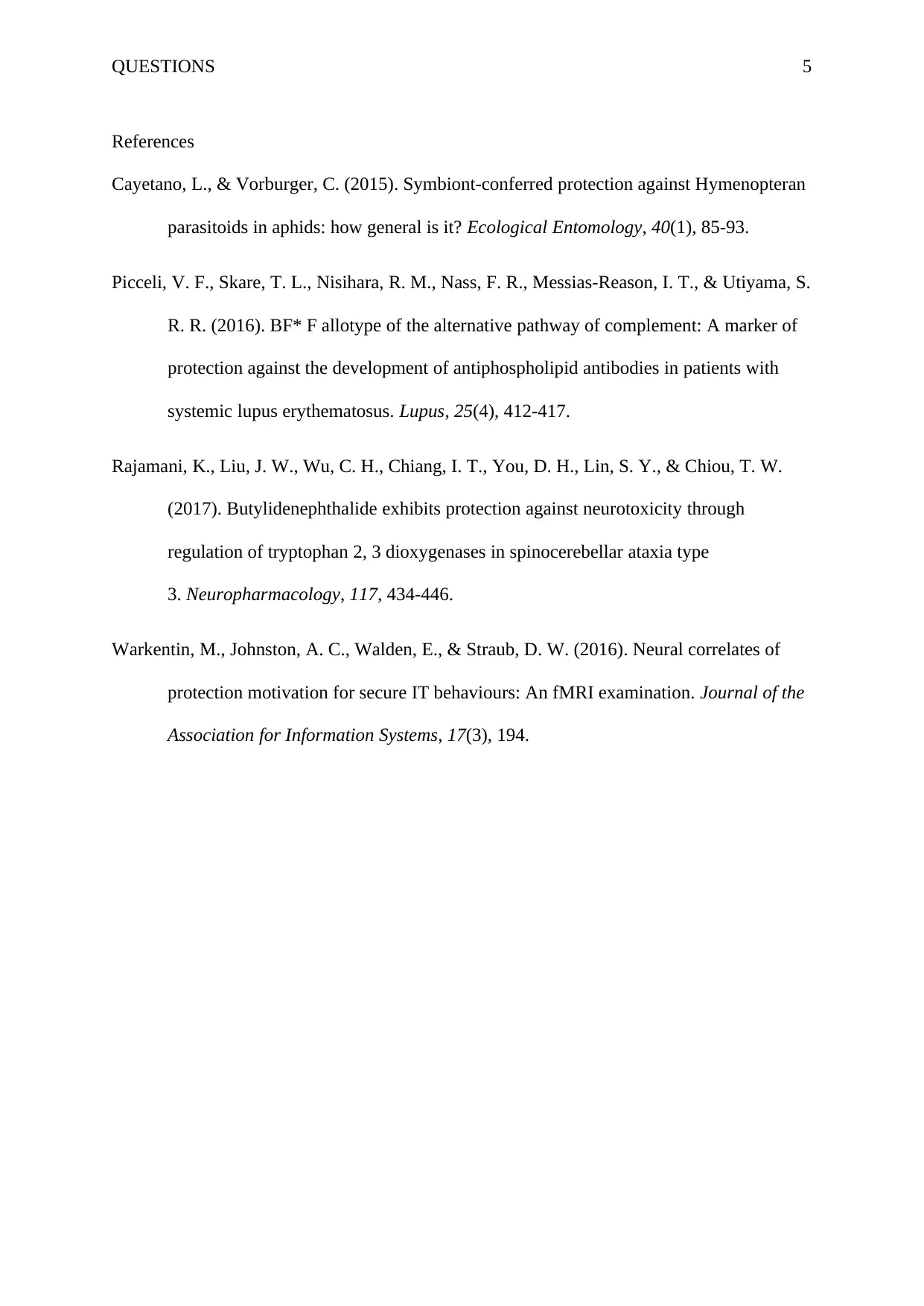
QUESTIONS 5
References
Cayetano, L., & Vorburger, C. (2015). Symbiont‐conferred protection against Hymenopteran
parasitoids in aphids: how general is it? Ecological Entomology, 40(1), 85-93.
Picceli, V. F., Skare, T. L., Nisihara, R. M., Nass, F. R., Messias-Reason, I. T., & Utiyama, S.
R. R. (2016). BF* F allotype of the alternative pathway of complement: A marker of
protection against the development of antiphospholipid antibodies in patients with
systemic lupus erythematosus. Lupus, 25(4), 412-417.
Rajamani, K., Liu, J. W., Wu, C. H., Chiang, I. T., You, D. H., Lin, S. Y., & Chiou, T. W.
(2017). Butylidenephthalide exhibits protection against neurotoxicity through
regulation of tryptophan 2, 3 dioxygenases in spinocerebellar ataxia type
3. Neuropharmacology, 117, 434-446.
Warkentin, M., Johnston, A. C., Walden, E., & Straub, D. W. (2016). Neural correlates of
protection motivation for secure IT behaviours: An fMRI examination. Journal of the
Association for Information Systems, 17(3), 194.
References
Cayetano, L., & Vorburger, C. (2015). Symbiont‐conferred protection against Hymenopteran
parasitoids in aphids: how general is it? Ecological Entomology, 40(1), 85-93.
Picceli, V. F., Skare, T. L., Nisihara, R. M., Nass, F. R., Messias-Reason, I. T., & Utiyama, S.
R. R. (2016). BF* F allotype of the alternative pathway of complement: A marker of
protection against the development of antiphospholipid antibodies in patients with
systemic lupus erythematosus. Lupus, 25(4), 412-417.
Rajamani, K., Liu, J. W., Wu, C. H., Chiang, I. T., You, D. H., Lin, S. Y., & Chiou, T. W.
(2017). Butylidenephthalide exhibits protection against neurotoxicity through
regulation of tryptophan 2, 3 dioxygenases in spinocerebellar ataxia type
3. Neuropharmacology, 117, 434-446.
Warkentin, M., Johnston, A. C., Walden, E., & Straub, D. W. (2016). Neural correlates of
protection motivation for secure IT behaviours: An fMRI examination. Journal of the
Association for Information Systems, 17(3), 194.
⊘ This is a preview!⊘
Do you want full access?
Subscribe today to unlock all pages.

Trusted by 1+ million students worldwide
1 out of 6
Your All-in-One AI-Powered Toolkit for Academic Success.
+13062052269
info@desklib.com
Available 24*7 on WhatsApp / Email
![[object Object]](/_next/static/media/star-bottom.7253800d.svg)
Unlock your academic potential
Copyright © 2020–2025 A2Z Services. All Rights Reserved. Developed and managed by ZUCOL.

